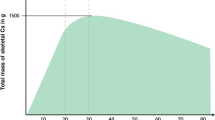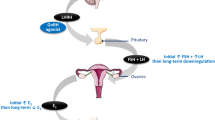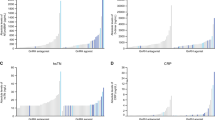Abstract
The intended therapeutic effect of gonadotropin-releasing-hormone (GnRH) agonists is hypogonadism, which is a leading cause of osteoporosis in men. Observations are consistent with this effect: GnRH agonists decrease bone mineral density and increase fracture risk in men with prostate cancer. Estrogens play a central role in homeostasis of the normal male skeleton and evidence suggests that estrogen deficiency is primarily responsible for the adverse skeletal effects of GnRH agonists. The mechanism of treatment-related bone loss involves acceleration of physiologic bone turnover. In small, randomized, controlled trials, bisphosphonates (pamidronate, zoledronic acid) and selective estrogen-receptor modulators (raloxifene, toremifene) increased bone mineral density in GnRH-agonist-treated men. Two ongoing large, randomized, placebo-controlled studies will prospectively define fracture outcomes in men with prostate cancer and assess the efficacy of novel pharmacologic interventions (AMG 162, toremifene) in GnRH-agonist-treated men.
This is a preview of subscription content, access via your institution
Access options
Subscribe to this journal
Receive 12 print issues and online access
$209.00 per year
only $17.42 per issue
Buy this article
- Purchase on Springer Link
- Instant access to full article PDF
Prices may be subject to local taxes which are calculated during checkout
Similar content being viewed by others
References
National Osteoporosis Foundation. Men and Osteoporosis [http://www.nof.org/men/index.htm] (accessed 28 September 2005)
Seeman E (1999) The structural basis of bone fragility in men. Bone 25: 143–147
Bilezikian JP (1999) Osteoporosis in men. J Clin Endocrinol Metab 84: 3431–3434
Orwoll ES (1998) Osteoporosis in men. Endocrinol Metab Clin North Am 27: 349–367
Gardsell P et al. (1990) The predictive value of forearm bone mineral content measurements in men. Bone 11: 229–232
van der Klift M et al. (2002) The incidence of vertebral fractures in men and women: the Rotterdam Study. J Bone Miner Res 17: 1051–1056
Cummings SR et al. (1990) Appendicular bone density and age predict hip fracture in women. The Study of Osteoporotic Fractures Research Group. JAMA 263: 665–668
Kanis JA et al. (1994) The diagnosis of osteoporosis. J Bone Miner Res 9: 1137–1141
Eastell R (1998) Treatment of postmenopausal osteoporosis. N Engl J Med 338: 736–746
Szulc P et al. (2000) Cross-sectional assessment of age-related bone loss in men: the MINOS study. Bone 26: 123–129
Snyder PJ et al. (2000) Effects of testosterone replacement in hypogonadal men. J Clin Endocrinol Metab 85: 2670–2677
Zojer N et al. (1999) Comparative tolerability of drug therapies for hypercalcaemia of malignancy. Drug Saf 21: 389–406
Zmuda JM et al. (2000) Posterior-anterior and lateral dual-energy x-ray absorptiometry for the assessment of vertebral osteoporosis and bone loss among older men. J Bone Miner Res 15: 1417–1424
Finkelstein JS et al. (1994) A comparison of lateral versus anterior-posterior spine dual energy x-ray absorptiometry for the diagnosis of osteopenia. J Clin Endocrinol Metab 78: 724–730
Grampp S et al. (1993) Radiologic diagnosis of osteoporosis. Current methods and perspectives. Radiol Clin North Am 31: 1133–1145
Schutte HE and Park WM (1983) The diagnostic value of bone scintigraphy in patients with low back pain. Skeletal Radiol 10: 1–4
Smith MR et al. (2004) Association between androgen deprivation therapy and fracture risk: a population-based cohort study in men with non-metastatic prostate cancer [abstract]. J Clin Oncol (Proc ASCO Ann Mtg) 22 (Suppl): 4507
Shahinian VB et al. (2005) Risk of fracture after androgen deprivation for prostate cancer. N Engl J Med 352: 154–164
Smith M et al. Risk of clinical fracture after gonadotropin-releasing hormone agonist therapy for prostate cancer. J Urol, in press
Daniell HW (1997) Osteoporosis after orchiectomy for prostate cancer. J Urol 157: 439–444
Townsend MF et al. (1997) Bone fractures associated with luteinizing hormone-releasing hormone agonists used in the treatment of prostate carcinoma. Cancer 79: 545–550
Hatano T et al. (2000) Incidence of bone fracture in patients receiving luteinizing hormone-releasing hormone agonists for prostate cancer. BJU Int 86: 449–452
Oefelein MG et al. (2001) Skeletal fracture associated with androgen suppression induced osteoporosis: the clinical incidence and risk factors for patients with prostate cancer. J Urol 166: 1724–1728
Melton LJ III et al. (2003) Fracture risk following bilateral orchiectomy. J Urol 169: 1747–1750
Dickman PW et al. (2004) Hip fractures in men with prostate cancer treated with orchiectomy. J Urol 172: 2208–2212
Diamond T et al. (1998) The effect of combined androgen blockade on bone turnover and bone mineral densities in men treated for prostate carcinoma: longitudinal evaluation and response to intermittent cyclic etidronate therapy. Cancer 83: 1561–1566
Maillefert JF et al. (1999) Bone mineral density in men treated with synthetic gonadotropin-releasing hormone agonists for prostatic carcinoma. J Urol 161: 1219–1222
Daniell HW et al. (2000) Progressive osteoporosis during androgen deprivation therapy for prostate cancer. J Urol 163: 181–186
Smith MR et al. (2001) Pamidronate to prevent bone loss during androgen-deprivation therapy for prostate cancer. N Engl J Med 345: 948–955
Berruti A et al. (2002) Changes in bone mineral density, lean body mass and fat content as measured by dual energy x-ray absorptiometry in patients with prostate cancer without apparent bone metastases given androgen deprivation therapy. J Urol 167: 2361–2367
Smith MR et al. (2003) Randomized controlled trial of zoledronic acid to prevent bone loss in men undergoing androgen deprivation therapy for nonmetastatic prostate cancer. J Urol 169: 2008–2012
Smith MR et al. (2004) Raloxifene to prevent gonadotropin-releasing hormone agonist-induced bone loss in men with prostate cancer: a randomized controlled trial. J Clin Endocrinol Metab 89: 3841–3846
Lee H et al. Changes in bone mineral density and body composition during initial and long-term gonadotropin-releasing hormone agonist treatment for prostate carcinoma. Cancer, in press
Leder BZ et al. (2001) Effects of gonadal steroid suppression on skeletal sensitivity to parathyroid hormone in men. J Clin Endocrinol Metab 86: 511–516
The Leuprolide Study Group (1984) Leuprolide versus diethylstilbestrol for metastatic prostate cancer. N Engl J Med 311: 1281–1286
Garnick MB (1986) Leuprolide versus diethylstilbestrol for previously untreated stage D2 prostate cancer: results of a prospectively randomized trial. Urology 27: 21–28
Need AG et al. (1996) Vitamin D receptor genotypes are related to bone size and bone density in men. Eur J Clin Invest 26: 793–796
Eriksen EF et al. (1988) Evidence of estrogen receptors in normal human osteoblast-like cells. Science 241: 84–86
Oursler MJ et al. (1994) Human giant cell tumors of the bone (osteoclastomas) are estrogen target cells. Proc Natl Acad Sci USA 91: 5227–5231
Falahati-Nini A et al. (2000) Relative contributions of testosterone and estrogen in regulating bone resorption and formation in normal elderly men. J Clin Invest 106: 1553–1560
Leder BZ et al. (2003) Differential effects of androgens and estrogens on bone turnover in normal men. J Clin Endocrinol Metab 88: 204–210
Slemenda CW et al. (1997) Sex steroids and bone mass in older men. Positive associations with serum estrogens and negative associations with androgens. J Clin Invest 100: 1755–1759
Khosla S et al. (1998) Relationship of serum sex steroid levels and bone turnover markers with bone mineral density in men and women: a key role for bioavailable estrogen. J Clin Endocrinol Metab 83: 2266–2274
Greendale GA et al. (1997) Endogenous sex steroids and bone mineral density in older women and men: the Rancho Bernardo Study. J Bone Miner Res 12: 1833–1843
Eriksson S et al. (1995) Bone mineral density in patients with prostatic cancer treated with orchidectomy and with estrogens. Calcif Tissue Int 57: 97–99
Scherr D et al. (2002) Diethylstilbesterol revisited: androgen deprivation, osteoporosis and prostate cancer. J Urol 167: 535–538
Orwoll E et al. (2000) Alendronate for the treatment of osteoporosis in men. N Engl J Med 343: 604–610
Dawson-Hughes B et al. (1997) Effect of calcium and vitamin D supplementation on bone density in men and women 65 years of age or older. N Engl J Med 337: 670–676
Giovannucci E et al. (1998) Calcium and fructose intake in relation to risk of prostate cancer. Cancer Res 58: 442–447
Chan JM et al. (1998) Dairy products, calcium, phosphorous, vitamin D, and risk of prostate cancer (Sweden). Cancer Causes Control 9: 559–566
Giovannucci E (1998) Dietary influences of 1,25(OH)2 vitamin D in relation to prostate cancer: a hypothesis. Cancer Causes Control 9: 567–582
Diamond TH et al. (2001) The antiosteoporotic efficacy of intravenous pamidronate in men with prostate carcinoma receiving combined androgen blockade: a double blind, randomized, placebo-controlled crossover study. Cancer 92: 1444–1450
Reid IR et al. (2002) Intravenous zoledronic acid in postmenopausal women with low bone mineral density. N Engl J Med 346: 653–661
Boyle WJ et al. (2003) Osteoclast differentiation and activation. Nature 423: 337–342
Bekker PJ et al. (2004) A single-dose placebo-controlled study of AMG 162, a fully human monoclonal antibody to RANKL, in postmenopausal women. J Bone Miner Res 19: 1059–1066
Taxel P et al. (2002) The effect of micronized estradiol on bone turnover and calciotropic hormones in older men receiving hormonal suppression therapy for prostate cancer. J Clin Endocrinol Metab 87: 4907–4913
Balfour JA and Goa KL (1998) Raloxifene. Drugs Aging 12: 335–342
Delmas PD et al. (1997) Effects of raloxifene on bone mineral density, serum cholesterol concentrations, and uterine endometrium in postmenopausal women. N Engl J Med 337: 1641–1647
Ettinger B et al. (1999) Reduction of vertebral fracture risk in postmenopausal women with osteoporosis treated with raloxifene: results from a 3-year randomized clinical trial. Multiple Outcomes of Raloxifene Evaluation (MORE) Investigators. JAMA 282: 637–645
Steiner MS et al. (2004) Toremifene citrate versus placebo for treatment of bone loss and other complications of androgen deprivation therapy in patients with prostate cancer [abstract]. J Clin Oncol (Proc ASCO Ann Mtg) 22 (Suppl): 4597
Verhelst J et al. (1994) Endocrine profiles during administration of the new non-steroidal anti-androgen Casodex in prostate cancer. Clin Endocrinol (Oxf) 41: 525–530
Sieber PR et al. (2002) Bone mineral density is maintained during bicalutamide ('Casodex') treatment [abstract #783]. Proc 2002 ASCO Ann Mtg [http://www.asco.org/ac/1,1003,_12-002636-00_18-0016-00_19-00783,00.asp] (accessed 28 September 2005)
Smith MR et al. (2004) Bicalutamide monotherapy versus leuprolide monotherapy for prostate cancer: effects on bone mineral density and body composition. J Clin Oncol 22: 2546–2553
Diamond TH et al. (2004) Osteoporosis in men with prostate carcinoma receiving androgen-deprivation therapy: recommendations for diagnosis and therapies. Cancer 100: 892–899
Bae DC and Stein BS (2004) The diagnosis and treatment of osteoporosis in men on androgen deprivation therapy for advanced carcinoma of the prostate. J Urol 172: 2137–2144
Cummings SR et al. (1993) Bone density at various sites for prediction of hip fractures. The Study of Osteoporotic Fractures Research Group. Lancet 341: 72–75
Author information
Authors and Affiliations
Corresponding author
Ethics declarations
Competing interests
Dr Matthew R Smith is a consultant for Amgen, GTx Inc., and Novartis Oncology.
Rights and permissions
About this article
Cite this article
Smith, M. Therapy Insight: osteoporosis during hormone therapy for prostate cancer. Nat Rev Urol 2, 608–615 (2005). https://doi.org/10.1038/ncpuro0326
Received:
Accepted:
Issue Date:
DOI: https://doi.org/10.1038/ncpuro0326
This article is cited by
-
Muscle function, physical performance and body composition changes in men with prostate cancer undergoing androgen deprivation therapy
Asian Journal of Andrology (2012)
-
Androgen-deprivation-therapy-induced fractures in men with nonmetastatic prostate cancer: what do we really know?
Nature Clinical Practice Urology (2008)
-
Drug Insight: the use of bisphosphonates for the prevention and treatment of osteoporosis in men
Nature Clinical Practice Urology (2007)
-
Cancer-associated bone disease
Current Osteoporosis Reports (2007)



